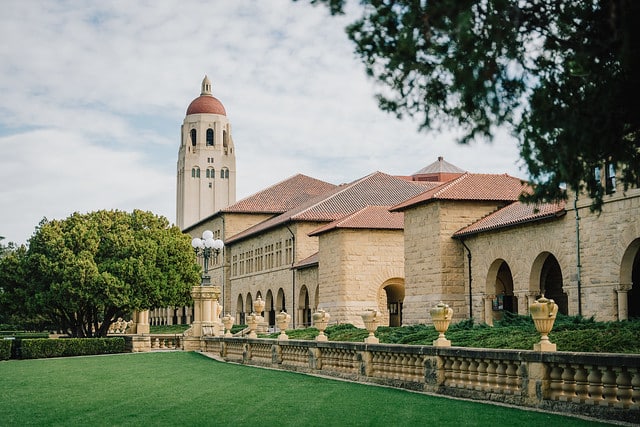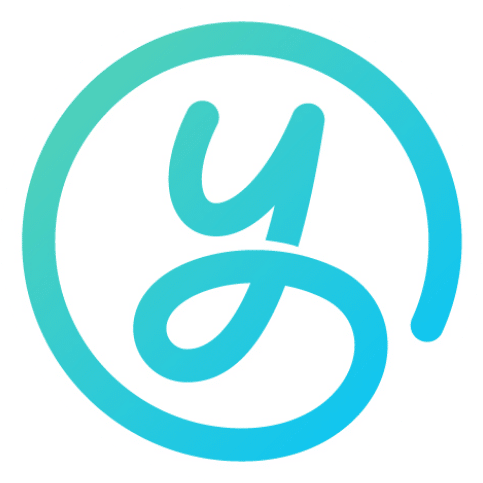Stanford is not only listed as one of the top universities in America but it’s ranked amongst the top 5 globally.
There are dozens of incredible reasons why you would be interested in attending Stanford; world-class education, gorgeous campus/location, financial aid program, and alumni network to name a few.
This guide clarifies the admissions process and offers actionable strategies to enhance your chances of getting into Stanford.
How Hard Is It To Get Into Stanford?
For clarification, Stanford is very hard to get into.
Stanford University has a reputation as one of the top schools in the nation, and one of the hardest colleges in the country to get into.

Stanford’s Acceptance Rate is 3.9%
The Stanford acceptance rate is 3.9%
Stanford doesn’t publicly announce their acceptance rate, however, a quick calculation using the Common Data Set places shows its 3.9% is a decrease from the previous year’s 5.19% acceptance rate.
How many Stanford applicants are there? 53,733 first-year students applied in 2023.
Out of the 2,099 that were accepted, 1,699 enrolled.
What is Stanford Admissions Looking For?
To gain acceptance into a school like Stanford, exceptional academics are not enough. Nearly every applicant has outstanding grades and test scores.
So what exactly are they looking for?
According to the common data set published by Stanford, certain things matter more than others.
‘Very Important’ Criteria
School Rigor
Basically, this is a document typically completed by a high school college counselor that provides Stanford with an understanding of the academic environment at your high school.
This information helps admissions committees evaluate an applicant’s performance relative to what is available at their school.
It looks at things like the school’s curriculum difficulty (AP, IB, honors courses offered), GPA distribution among students, the number of students attending college, the types of colleges recent graduates attend, and school demographics.
Specifically at Stanford, to submit a competitive application you’ll need all, or mostly all A’s while taking the most challenging courses available.
Students accepted to a top 10 school like Stanford typically complete between 8 and 12 APs, but it’s not uncommon for a student to have taken even more.
Class Rank
Stanford considers class rank “very important” to admissions decisions.
A remarkable 96% of the University’s class of 2026 graduated in the top 10% of their respective high school class.
And 99.5% of incoming freshmen were in the top quarter of their high school graduating class.
Academic/GPA
Stanford’s evaluation goes beyond any numerical formula.
However the primary criterion for admission to Stanford is academic excellence.
They expect you to challenge yourself throughout high school and expect you to excel throughout.
The most important credential for evaluating your academic record is your transcript.
But there is no minimum GPA.
No required test score.
Nor is there any specific number of AP or honors courses you must have on your transcript to have your application reviewed or be admitted to Stanford.
The best insights we can share are:
- The incoming class had an average GPA of 3.95
- 94% of the class graduated high school with a 3.75 GPA or above
So although there is no minimum, you can assume you’ll need at least a 3.75
You should not be aiming for anything short of a 4.0 to maximize your chances of acceptance.
Application Essays (Common App & Stanford Essays)
Stanford considers essays to be a “very important” criterion when making admissions decisions.
These essays provide an excellent opportunity for applicants to show why they belong at Stanford. But, if not written well, they will hinder your chances of acceptance.
Stanford requires both the Common App and college-specific essays:
- Common App. Submit one response to the prompts.
- Stanford Essays. Stanford’s application includes a writing supplement featuring:
- 5 short answer questions (50 words max)
- 3 long answer prompts (100-250 words)
Short Response Questions:
- What is the most significant challenge that society faces today?
- How did you spend your last two summers?
- What historical moment or event do you wish you could have witnessed?
- Briefly elaborate on one of your extracurricular activities, a job you hold, or responsibilities you have for your family.
- List five things that are important to you.
Essay Questions:
- Prompt 1: The Stanford community is deeply curious and driven to learn in and out of the classroom. Reflect on an idea or experience that makes you genuinely excited about learning.
- Prompt 2: Virtually all of Stanford’s undergraduates live on campus. Write a note to your future roommate that reveals something about you or that will help your roommate — and us — know you better.
- Prompt 3: Please describe what aspects of your life experiences, interests, and character would help you make a distinctive contribution as an undergraduate to Stanford University.
Recommendation / Guidance Letter
Stanford requires two Letters of Recommendation.
Letters from classroom teachers are strongly preferred.
We recommend requesting letters from grade 11 or 12 teachers in English, math, science, world language or history/social studies.
You may request a letter from a grade 10 teacher if the coursework was advanced (e.g., Honors, AP, IB).
If there is another person who knows you well and can provide new insights about you, you may have one additional recommender submit a letter on your behalf (not mandatory).
You can assign this person as your “Other Recommender” in the Common Application.
Extracurriculars
Stanford is interested in learning about your extracurricular activities and nonacademic interests to help them understand your potential contributions to the Stanford community.
Students often assume the more experiences they participate in, the better.
This is not the case.
Stanford seeks student’s who have extracurriculars of exceptional depth and that demonstrate your passion more than minimal participation in 5 or 6 different activities.
It’s vital you communicate the impact these experiences have had on you – whether you talk about being a part of a club, a sports team, a job, or family responsibilities.
If you’re looking for unique extracurricular activities to help differentiate you from other applicants, consider Youthfully’s Extracurricular program.
Talent/Abilities
Stanford specifically state that in some cases, exceptional abilities, such as athletics may influence our decision if the applicant is otherwise well qualified, but such abilities never, by themselves, ensure admission to Stanford.
Character/Personal Qualities
Stanford also heavily weights an applicant’s personal qualities and character.
A clear demonstration of Stanford’s core values is a good approach. Their website lists the following; Integrity, Diversity, Respect, Freedom of Inquiry and Expression, Trust, Honesty and Fairness
Stanford’s admission staff is specifically seeking students who demonstrate ‘Intellectual Curiosity’.
These students have a drive and passion for intellectual development.
Admissions officers want to see a certain level of curiosity and excitement that will encourage discussions, challenge the way you and fellow classmates think, and lead to new discoveries.
Stanford needs to ensure your growth didn’t peak in high school, and that you’ll be willing to continue putting in the effort to expand your horizons.
If you need help crafting your story and presenting it creatively and compellingly, consider partnering with an Admission Coach.
Considered’ Criteria
SAT/ACT
Although Stanford is ‘Test-Optional’, standardized testing is part of the application that can highlight academic preparedness.
If you do opt to subit test scores, there is no score that guarantees admission.
The majority of students who submitted SAT and ACT scores, the middle 50% were between 1500 and 1570 (SAT) and 33 and 35 (ACT) respectively.
Interview
The optional interview lets applicants engage in meaningful discussions with Stanford alumni.
It’s a chance for both sides to gain insights: you can learn more about Stanford, and the Admission Office can learn more about you.
If you’re in one of Stanford’s interview regions, you might get invited to an interview.
But even if you’re in these areas, it’s possible you won’t be offered one, since Stanford has limited interviewers.
If you don’t get contacted, don’t take it as a negative reflection on your application.
However, if you do get offered an interview, we strongly suggest you accept. Interviews are valuable opportunities to expand upon and enrich your application.
Work Experience & Internships
The same things as extracurricular activities apply here.
Racial/Ethnic & First-Generation
They will take into consideration minority racial/ethnic backgrounds and first-generation college applicants to ensure a diverse and equitable student body.
Stanford Legacy Applicants
Stanford acknowledges ‘primary legacy’ applicants – meaning one or both of your parents are alumni from Stanford.
Acceptance rate for legacy students can be up to 4x higher than non-legacy students.
‘Not Considered’ Criteria
Stanford does not give preference to California applicants.
As a globally ranked private school, Stanford is seeking the top applicants regardless of geographical location.
Religious affiliation
Stanford does not care about religious affiliation.
Applicant’s level of interest.
Stanford does care about the applicant’s level of interest.

How to Improve Chances of Getting Into Stanford
We have four main suggestions for improving your chances of getting into Stanford.
- Write creative and compelling essays
- Develop meaningful extracurriculars that align with Stanford’s values
- Inherit a Glowing letter of recommendation
Write Incredible Essays
Recall Stanford requires students to write common app essays, short answer questions, and long answers.
These essays are the ‘trailer’ to what it will be like to have you on campus. We
You must write them in a way that is creative and compelling and will differentiate you from other applicants.
Here are some tips to get you started.
- Don’t waste space with a lead-in sentence.
- Try to avoid overanalyzing what you think the admissions officers want you to write about. misses the point of showcasing your individuality.
- Watch out for writing about an issue in overly vague terms.
- Come up with out-of-the-box answers that ultimately make you more memorable
- Be genuine. Communicate your authentic passions. Don’t try to be someone you’re not. The admissions committee will be able to tell if you’re being artificial.
- Stanford is looking for what makes you unique and how you will share that uniqueness with their community.
If you are looking for more support with these written responses, consider working with a Youthfully Coach who specializes with Stanford and other schools you may be applying to.
.
Develop Large Impact Extracurriculars that Align with Stanford’s Values
As mentioned, Stanford is not looking for students with minimal participation in 5-6 clubs or less impactful extracurriculars.
They want students who have demonstrated a high level of achievement and are involved with 2-3 extraordinary extracurriculars.
Think about how many applications the admission committee is reading through.
Students who are all involved in common clubs or activities have a much more difficult time standing out from their peers who have significant, high-impact experiences to speak to.
If you still have time, meaning you’re not already a senior. Aim to develop high-impact experiences that positively impact people beyond just your school, community, or town. Think nationally or even internationally.
You don’t want to be a big fish in a small pond.
To get into Stanford, you want to be a big fish in a big pond.
Here are a few examples of ‘Large Impact’ extracurriculars:
- Contributing to the scientific community by publishing a research paper
- Develop a device and get it a patent
- Start a business (and scale it!)
- Participate in a prestigious internship that solves real-world problems
- Develop an app that solves a common pain point for others across the country
- Win a State Championship and do more than just break a school record
- Earn government funding for a significant project
If this list seems overwhelming or you’re not sure exactly where to get started. Consider enrolling in Youthfully’s Extracurricular program.
Inherit a Glowing Letter of Recommendation
Because Stanford puts such great emphasis on recommendation letters, you must do everything you can do get 2+1 extraordinary letters.
It’s not just about academic performance but building meaningful connections with teachers and counselors who influence your admission.
Think about how many letters teachers and guidance counselors have to write for each student.
Make yourself memorable by demonstrating genuine interest.
Actively participate in class, engage in discussions, and show initiative beyond the classroom.
By putting in the extra effort across all your interactions, you are encouraging them to go above and beyond with what they write for you.
Here are some strategies you can start doing right now to better your chances of getting a good letter when the time comes:
- Be Memorable: Actively participate in class, join teacher-involved extracurriculars, and attend office hours for coursework discussions.
- Choose Wisely: Select teachers familiar with your strengths, character, and achievements.
- Provide Information: Give teachers a packet with your resume, accomplishments, and details about your target programs or schools to tailor their letters.
- Give Ample Notice: Request letters well before deadlines to allow for thoughtful writing.
- Be Respectful: Approach teachers professionally, explaining why you chose them and expressing gratitude for their support.
- Follow-up: Ensure timely submission of letters and express appreciation with a thank-you note.
Does Stanford Do Early Admission?
Yes, Stanford has a Restrictive Early Action program and a Regular Decision Option.
Stanford’s Restrictive Early Action program provides students with the opportunity to apply early and receive an admission decision before the regular decision deadline.
This allows students to have more time to explore their options and make an informed decision about their college education.
Restrictive Early Action
Restrictive Early Action (REA) at Stanford is an early application option that isn’t binding.
REA might be a good choice for you if:
- Stanford is your top-choice school.
- You’ve tackled a challenging 11th-grade academic schedule and have a strong transcript to show for it.
- Your extracurricular activities have had a significant impact and don’t need more time to develop.
- You have enough time to craft a thoughtful application before the November 1 deadline.
Stanford aims to make final decisions whenever possible, so they only defer a small percentage of REA applications to Regular Decision.
If your REA application is deferred, you’ll receive a final decision by early April.
If you are not deferred, you will receive your admission decision mid December.
If you’re considering applying REA to Stanford, be sure to understand their policies:
- You can’t apply to any other private college or university under their early action, restrictive early action, early decision, or early notification plan.
- You can’t apply to any public university under an early binding plan, like Early Decision.
- If you apply REA to Stanford, you can apply to other colleges and universities under their Regular Decision plan.
- If you apply REA to Stanford and aren’t admitted or your application is deferred, you can apply to another college’s Early Decision II plan.
There are some exceptions to these rules:
- Any public college or university with a non-binding early application plan or early application deadline.
- Any college or university with a non-binding rolling admission process.
- Any foreign college or university with a non-binding application plan on any schedule.
- Any military academy.
- Any college or university with an early deadline for a scholarship or special academic program, as long as it’s non-binding and applying early is necessary to be considered.
Stanford Admissions Requirements & Criteria
Regular Decision (RD) is Stanford’s traditional decision plan. Most students, including a majority of admitted students, apply to Stanford during this round.
You may want to consider Regular Decision if any of the following applies:
- Your grades are on an upward trend
- You are taking classes in your senior year that are significantly more rigorous than in grades 10 and 11
- You are taking (or retaking) standardized exams
- You are working on a significant project or activity in the fall of your final year in high school.
The deadline to submit your RD application is January 5th.
You will receive your admissions decision by early April.
Stanford applicants can apply using either the Common Application or the Coalition Application.
For low-income students, Stanford is a partner of any students applying through Questbridge.
Special Admissions
Select Stanford Art Programs have specific dates and additional information for their undergrad applicants.
You are required to submit what Stanford refers to as an Arts Portfolio.
This 2-page PDF directly from Stanford’s website covers everything you need to know!
Arts Portfolio applicants have often received significant awards and honors at a state, national, or international level.
Any student who wishes to highlight their extraordinary talent in the fine or performing arts is welcome to submit an Arts Portfolio.


